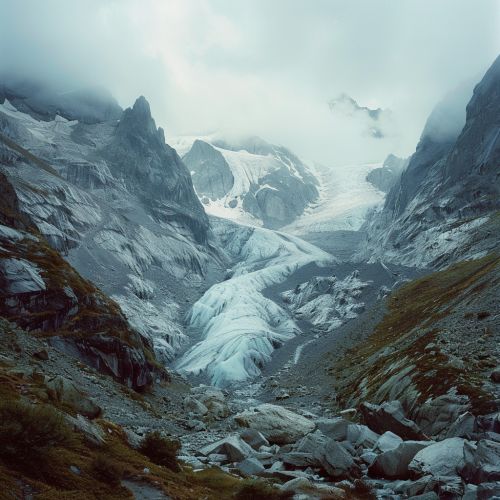Glacier morphology
Introduction
Glacier morphology is the study of the forms and structures of glaciers and the processes that shape them. Glaciers are dynamic systems that respond to climatic conditions and exert significant influence on the landscape. This article delves into the intricate details of glacier morphology, examining the various types of glaciers, their structural components, and the geomorphological processes involved.
Types of Glaciers
Glaciers can be classified based on their morphology, thermal characteristics, and dynamics. The primary types include:
Alpine Glaciers
Alpine glaciers, also known as mountain glaciers, are found in mountainous regions. They typically form in cirques, which are bowl-shaped depressions on the sides of mountains. These glaciers flow down valleys and are often confined by the topography.
Ice Sheets
Ice sheets are massive glaciers that cover vast areas of land, exceeding 50,000 square kilometers. The Antarctic Ice Sheet and the Greenland Ice Sheet are the two existing examples. Ice sheets are so thick that they submerge the underlying topography.
Ice Caps
Ice caps are smaller than ice sheets and cover less than 50,000 square kilometers. They are dome-shaped and spread out from their center. Ice caps are found in polar and subpolar regions.
Piedmont Glaciers
Piedmont glaciers occur when valley glaciers extend beyond the confines of their valleys and spread out onto relatively flat plains. This type of glacier forms a broad lobe of ice.
Tidewater Glaciers
Tidewater glaciers terminate in the sea, where they often calve to form icebergs. These glaciers are influenced by both terrestrial and marine processes.


Structural Components of Glaciers
Glaciers consist of several distinct structural components, each playing a critical role in their dynamics and morphology.
Accumulation Zone
The accumulation zone is the upper part of a glacier where snowfall exceeds melting and sublimation. This area is crucial for the growth of the glacier, as it is where ice is added.
Ablation Zone
The ablation zone is the lower part of a glacier where melting, sublimation, and calving exceed the accumulation of ice. This zone is characterized by a net loss of ice.
Firn Line
The firn line, or equilibrium line, marks the boundary between the accumulation and ablation zones. It is the altitude at which annual accumulation equals annual ablation.
Crevasses
Crevasses are deep cracks in the glacier surface caused by differential movement and stress. They can be classified into transverse, longitudinal, and radial crevasses based on their orientation.
Icefalls
Icefalls occur where a glacier flows over a steep drop or cliff, causing the ice to break apart and form a chaotic jumble of ice blocks.
Glacier Dynamics
The movement and flow of glaciers are driven by gravity and influenced by various factors, including temperature, ice thickness, and bedrock topography.
Internal Deformation
Internal deformation is the process by which ice crystals within the glacier deform and slide past one another. This movement is facilitated by the presence of liquid water at grain boundaries.
Basal Sliding
Basal sliding occurs when the glacier slides over its bed due to the presence of meltwater, which acts as a lubricant. This process is more common in temperate glaciers.
Subglacial Processes
Subglacial processes involve interactions between the glacier and its bed, including erosion, sediment transport, and deposition. These processes shape the landscape beneath the glacier.
Glacier Erosion and Deposition
Glaciers are powerful agents of erosion and deposition, capable of reshaping entire landscapes.
Glacial Erosion
Glacial erosion occurs through processes such as plucking and abrasion. Plucking involves the glacier pulling away pieces of bedrock, while abrasion grinds down the rock surface with debris embedded in the ice.
Glacial Landforms
Glacial erosion creates distinctive landforms, including:
- Cirques: Bowl-shaped depressions where glaciers originate.
- Arêtes: Sharp ridges formed between adjacent glaciers.
- Horns: Pyramid-shaped peaks created by the erosion of multiple glaciers.
Glacial Deposition
Glacial deposition occurs when glaciers lose their capacity to carry debris, leading to the formation of various depositional features.
Moraines
Moraines are accumulations of debris deposited by glaciers. They can be classified into several types, including lateral, medial, and terminal moraines.
Drumlin Fields
Drumlins are streamlined, elongated hills formed by glacial deposition. They indicate the direction of glacier movement.
Climate Influence on Glacier Morphology
Glacier morphology is highly sensitive to climatic conditions. Changes in temperature and precipitation directly impact glacier mass balance and dynamics.
Glacial Advance and Retreat
Glacial advance occurs when accumulation exceeds ablation, causing the glacier to grow and extend. Conversely, glacial retreat happens when ablation surpasses accumulation, leading to glacier shrinkage.
Paleoclimatology
The study of glacier morphology provides valuable insights into past climatic conditions. Glacial landforms and deposits serve as records of historical climate changes.
Conclusion
Understanding glacier morphology is essential for comprehending the dynamics of these powerful natural systems and their impact on the environment. The study of glaciers not only reveals past climatic conditions but also helps predict future changes in response to global warming.
